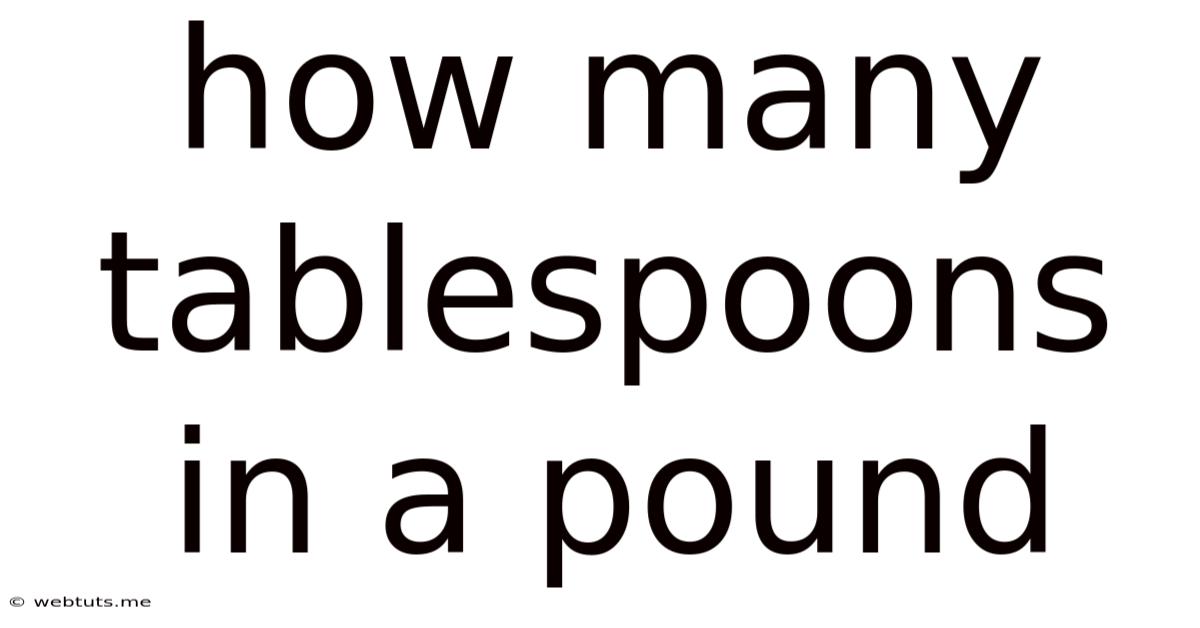How Many Tablespoons In A Pound
Webtuts
Mar 23, 2025 · 4 min read

Table of Contents
How Many Tablespoons in a Pound? A Comprehensive Guide to Cooking Conversions
Understanding cooking measurements is crucial for culinary success. Whether you're a seasoned chef or a baking novice, mastering conversions is key to achieving consistent and delicious results. One conversion that often causes confusion is determining how many tablespoons are in a pound. This comprehensive guide will delve into this conversion, exploring various ingredients and offering helpful tips for accurate measurements.
The Complicated Truth: It Depends on the Ingredient
Unlike converting between metric and imperial units where the conversion is always consistent (e.g., 1 kilogram is always equal to 2.20462 pounds), the number of tablespoons in a pound varies significantly depending on the density of the ingredient. A pound of feathers will obviously occupy a much larger volume than a pound of lead, even though they both weigh the same. Similarly, a pound of flour will have a different number of tablespoons than a pound of sugar or a pound of butter.
This means there's no single definitive answer to the question, "How many tablespoons are in a pound?" Instead, we need to consider the specific ingredient.
Understanding Density and its Impact on Volume
Density is a measure of how much mass is contained within a given volume. A denser substance will have more mass packed into the same volume compared to a less dense substance. This difference in density directly affects the volume (and therefore the number of tablespoons) in a pound of a given ingredient.
Conversion Challenges: Why it's Not a Simple Calculation
The difficulty in calculating tablespoons per pound stems from the inconsistent nature of ingredients. Factors like:
- Granularity: Fine granulated sugar packs more tightly than coarse sugar.
- Moisture Content: Wet ingredients, like butter or honey, will have different densities than their dry counterparts.
- Ingredient Type: The inherent structure of different ingredients contributes to varying densities. For example, flour is much less dense than sugar.
Approximate Conversions for Common Cooking Ingredients
While a precise conversion isn't possible without knowing the specific density of the ingredient, we can provide some approximate conversions for commonly used ingredients. These are averages and may vary slightly depending on the brand and specific conditions:
Dry Ingredients:
- All-Purpose Flour: Approximately 32 tablespoons per pound. This can fluctuate depending on the type of flour (e.g., cake flour, bread flour) and how tightly it's packed.
- Granulated Sugar: Roughly 32-36 tablespoons per pound. Again, this varies with granularity and packing.
- Powdered Sugar: Approximately 40 tablespoons per pound, due to its finer texture.
- Brown Sugar: Around 28-30 tablespoons per pound, as its moisture content reduces density.
Wet Ingredients:
- Butter (unsalted): Approximately 30 tablespoons per pound. This is for softened, not melted butter.
- Honey: Roughly 28 tablespoons per pound. The viscosity affects its volume.
- Oil (vegetable, olive): Approximately 29-30 tablespoons per pound. Again, slight variations depending on the type of oil.
Important Note: These values are estimations. For precise recipes, especially in baking, it's always best to use a kitchen scale to weigh your ingredients.
Using a Kitchen Scale for Accurate Measurements
The most reliable method for precise baking and cooking is to use a kitchen scale. Kitchen scales measure ingredients by weight, eliminating the inconsistencies inherent in volume measurements. Using a scale ensures consistent results, regardless of ingredient density or packing.
Why Weight is Superior to Volume in Baking (and Sometimes Cooking)
Baking, in particular, is a science. Precise ratios of ingredients are essential for proper structure and texture. Volume measurements, like cups and tablespoons, are prone to errors due to the factors mentioned earlier (density, packing, moisture content). Weight measurements bypass these issues, ensuring consistent results every time.
Troubleshooting Common Measurement Issues
- Lumpy Ingredients: When scooping dry ingredients from a container, avoid packing them down. Use a light scoop to ensure proper volume. For best accuracy, spoon the ingredient into the measuring cup.
- Inconsistent Packing: Aim for consistent packing when using volume measurements to maintain consistency between batches.
Advanced Techniques for Precise Measurements
For professionals or serious home bakers who need extreme accuracy, specialized tools can further enhance precision:
- Displacement Measurement: This method involves submerging an object in water to measure the volume of water it displaces, providing a precise volume measurement.
- Laboratory-Grade Balances: These highly accurate scales are used in settings where precision is paramount.
Conclusion: Mastering the Art of Measurement
While a simple answer to "how many tablespoons are in a pound?" doesn't exist, understanding the principles of density and using appropriate measuring techniques (primarily weight-based measurements) ensures consistent and successful outcomes. Embrace kitchen scales for baking and be mindful of ingredient-specific approximations for volume measurements. With practice and careful attention to detail, you'll master the art of measurement and create delicious and consistent results every time. Remember, accuracy is key, especially in baking where small variations can significantly impact the final product.
Latest Posts
Latest Posts
-
How To Calculate Your Raise Percentage
May 09, 2025
-
How Many Acres Is 1000 Square Miles
May 09, 2025
-
How Much Does A Sheet Of Half Inch Plywood Weigh
May 09, 2025
-
What Is 95 F In Celsius
May 09, 2025
-
How Many Ounces Are In A 1 4 Pound
May 09, 2025
Related Post
Thank you for visiting our website which covers about How Many Tablespoons In A Pound . We hope the information provided has been useful to you. Feel free to contact us if you have any questions or need further assistance. See you next time and don't miss to bookmark.